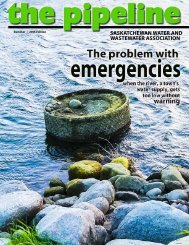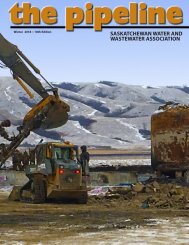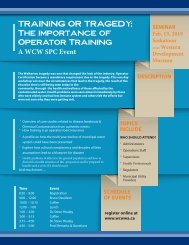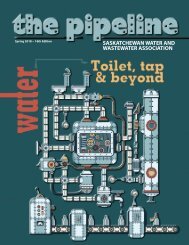September 2019 Publication
You also want an ePaper? Increase the reach of your titles
YUMPU automatically turns print PDFs into web optimized ePapers that Google loves.
SWWA 2018 CONFERENCE Technical Sessions<br />
TS #1 – Squamish WWTP Automation<br />
Upgrade – Breathing New Life into<br />
Aging Infrastructure<br />
Presenter: Zane Spencer - MPE<br />
The District of Squamish WWTP was originally<br />
constructed 1996 and has undergone<br />
significant additions and modification over its<br />
life. The original control system for the facility<br />
had been expanded and augmented over the<br />
years but was rapidly approaching end of life.<br />
Faced with the prospect of ordering spare<br />
parts off the Internet, the District began<br />
planning for a replacement of the control<br />
system prior to 2015. In the summer of 2017<br />
the District issued an RFP for the design and<br />
programming of a new automation system.<br />
Collaboration between the District, MPE<br />
Engineering and a local electrical contractor<br />
saw the project go from concept to<br />
completion in an extremely short time frame.<br />
This case study will discuss the following<br />
topics:<br />
• Pre-migration control system architecture<br />
• Drivers for migration<br />
• Preliminary work undertaken by the<br />
district<br />
• Selection of an engineering consultant<br />
• Design considerations & process<br />
• Selection of an electrical contractor<br />
• Migrating the control system during<br />
continuous operation of the WWTP<br />
• Final control system architecture<br />
• Operations staff adjustment to new<br />
system<br />
• Benefits to final systems for operators,<br />
managers and support staff<br />
Attendees will gain knowledge related to<br />
upgrading or migrating a process control in<br />
an operational facility. The case study will<br />
include input from operations and<br />
maintenance staff into the issues with the<br />
legacy control system, the migration process<br />
and the benefits realized after the migration<br />
was completed.<br />
TS #2 - PipePatch Trenchless Point Repair Technology<br />
Presenter: Michael O’Toole – Fernco<br />
Cities across Canada are constantly faced with stretching budget dollars to<br />
improve and repair the underground infrastructure. With an eye on the bottom<br />
line, new repair methods and technology are needed to increase work capacity<br />
and productivity each day.<br />
Source One Environmental (S1E) PipePatch offers a no-dig, trenchless pipe<br />
rehabilitation system for pipe diameters up to 72”. An alternative to ‘dig and<br />
replace’ methods, the PipePatch product line challenges traditional pipe repair<br />
methods as an efficient long-lasting solution that meets NSF standards, ICC-<br />
EW-PMG standards, and is environmentally friendly.<br />
PipePatch is a Cured-In-Place-Pipe (CIPP) sectional repair that eliminates the<br />
need for digging by creating a mechanical bond to the original pipe with<br />
minimal change to the original diameter, exceeding ASTM F1216 standards.<br />
When compared to digging or lining an entire pipe, PipePatch only repairs areas<br />
that require rehabilitation—saving time, investment, and labor.<br />
Supplied in a kitted format, each PipePatch kit contains the necessary premeasured<br />
items including resin, fiberglass mat, and other consumables, to carry<br />
out a successful trenchless repair. The precisely measured consumables ensure<br />
a simple and repeatable repair. This process eliminates the need for large<br />
storage areas, installation guess-work, and excess product waste.<br />
PipePatch utilizes a patented, non-hazardous resin that is odor-less, nonflammable,<br />
and doesn’t contain any VOCs or Styrene. While it is beneficial to<br />
clean debris from the area of repair, the presence of water and infiltration does<br />
not limit the ability to complete a trenchless repair. The resin has outstanding<br />
bonding properties, with resistance to 63+ chemicals.<br />
Through discussions with municipalities and contractors, cities across Canada<br />
are taking note of PipePatch’s benefits to save money and time. By repairing<br />
and improving Canada’s existing infrastructure, the country can strategize and<br />
budget for future asset management. PipePatch is the solution for Canada’s<br />
stretched infrastructure budgets.<br />
never stop learning;<br />
TS #3 - “Gas Detection Safety in the Water and<br />
Wastewater Industry”<br />
Presenter: Marc Goldade – Carbon Controls<br />
Dealing with the toxic and combustible gases created as byproducts<br />
through the process of water purification and<br />
sewage treatment can be hazardous if not dealt with correctly.<br />
Even small amounts of explosive and toxic gas can create<br />
unsafe working conditions that if not corrected could result in<br />
possible plant shutdowns, medical issues or even employee<br />
death. This presentation will look at the evolution of<br />
technology in gas detection equipment, the role gas detection<br />
plays in the water and wastewater industry, special<br />
considerations when applying gas detection, as well as how to<br />
properly maintain your gas detection system. Whether the gas<br />
in question is methane, ammonia, carbon dioxide, chlorine,<br />
hydrogen sulfide, nitric oxide, nitrogen dioxide, ozone, oxygen<br />
deficiency or a combination of the above, Carbon Controls can<br />
help formulate a solution. Attendees will be educated on how<br />
gas detection operates as well as how best to incorporate gas<br />
detection into their overall safety system.<br />
Some highlights of the presentation will include:<br />
• A brief history of the gas detection in water and<br />
wastewater<br />
• An overview of existing and new technology in gas<br />
detection<br />
• A look at what environmental conditions should be<br />
considered when selecting and gas detection<br />
• How gas detection its into the overall safety system<br />
• How to properly maintain your gas detection equipment<br />
for when we stop learning,<br />
we stop growing. Loyal “Jack” Lewman<br />
TS #4 - Replace your old “traditional” air/vac release<br />
valves with “innovative” maintenance friendly<br />
air release valves<br />
Presenter: Dave Brewer - Utility Supply West Corp.,<br />
Air Release valves play an important role in a<br />
water/wastewater system. They can extend a piping<br />
systems life by helping in avoiding the following:<br />
• 1- Air in pipeline leads to increasing pressure and<br />
reducing flow rate periodically.<br />
• 2- Air trapped in pipelines increase corrosion and<br />
provide a place for bacterial activities on pipeline<br />
coating<br />
• 3- Air pockets in pipelines sometimes move along<br />
pipeline that results in transmission pressures in<br />
pipeline and affects pump efficiency<br />
• 4- Air Aggregation in pipeline connections increase the<br />
possibility of pipeline failures.<br />
• 5- Due to a very lower density of air rather that water,<br />
air rapidly exits from gaps and air valves. This leads to<br />
increasing Acceleration of water column behind air<br />
pockets and accruing high pressures.<br />
With these factors needing to be considered and accounted<br />
for in a piping system-it is crucial that maintenance of he air<br />
valves be maintained in a regular manner. Not doing so can<br />
potentially lead to failures that at the very least interrupt a<br />
customer’s service or in a worst-case scenario contribute to<br />
a catastrophic failure due to air accumulation.<br />
When considering an air/vac release valve, options are<br />
available that can make maintenance much simpler for the<br />
operator.<br />
Using materials such as 316 Stainless steel in the<br />
construction of the air release valve provides excellent<br />
corrosion resistance in most environments seen in a<br />
water/waste water system. As well having easy access to the<br />
air release valve without the maintenance being performed<br />
within a “confined space” reduces risk to the operator.<br />
The H Tec air release valve offers a product that allows for<br />
easy access from above ground, making a proper<br />
maintenance routine much easier for the utility to<br />
implement on a regular basis, thus extending the life of the<br />
asset.<br />
These types of air release valves are available and will be<br />
discussed in detail as well as other innovative designs from<br />
H-Tec that make it easier for the owner/operator to choose<br />
the proper air release valve for their system.
















